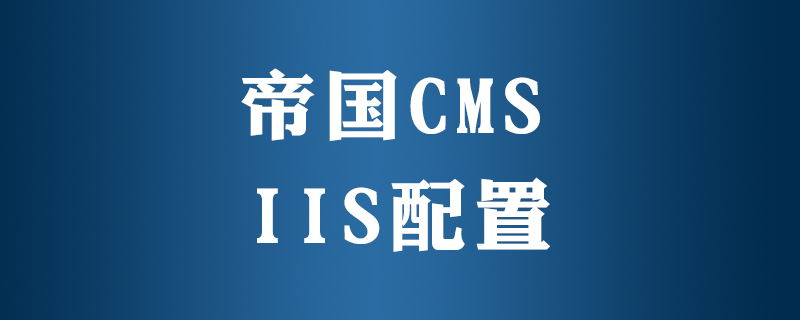

Recommended tutorial: Empire cms tutorial
Note: Assume that the environment is installed in D:\Ecms and the website is installed in E:\WEB
##1. Extract the one-click installation package to D:\ (of course it can also be under other drive letters). The folder name is EmpireServer. Change the folder name to Ecms (custom)
2. Move the D:\Ecms\web folder to E:\
3. Modify the D:\Ecms\php\php5\php.ini file
Find EmpireServer and modify it to Ecms (There are a total of everywhere), note that this example environment is all under the D drive. If it is changed to another drive letter such as E:, then change D:\EmpireServer to E:\Ecms, and change D:/EmpireServer to E :/Ecms (The two slashes are in different directions).
4. Copy the php.ini file to the c:\windows folder;
5. Modify the D:\Ecms\php\mysql5\my.ini file
Change D:/EmpireServer to D:/Ecms ( There are two places)
6. Open D:\Ecms\php\php5 and copy the two files php5ts.dll and libmysql.dll to the c:\windows\system32 file;
7. Modify D:\Ecms\one-click installation.bat batch file
##① Shield the installation and startup of apache (Because IIS is used, there is no need to install apache), just write the REM command before the corresponding statement. There are two sentences that need to be modified ( both contain apache )##
②Modify D:\EmpireServer to D:\Ecms
③Double-click One-click installation .bat to install the empire cms environment (actually only mysql is installed)
8.IIS Settings:
①Open the Internet Information Services Manager and select "Default Website" ( Or other websites preparing to use PHP), right-click and select properties;
②Select the "ISAPI Filter" tab, click the "Add..." button, and click /Edit Filter Properties" dialog box, enter PHP in the filter name, and enter D:\Ecms\php\php5\php5isapi.dll in the executable file box;
③Select the "Home Directory" tab, modify the "local path" of the website to E:\web, click the "Configure..." button, "Add..." in the "Application Extension" dialog box, and in the pop-up " "Add/Edit Application Extension Mapping", you may enter D:\Ecms\php\php5\php5isapi.dll in the executable file, and enter .php in the extension (Note that there is a bit ), click the "Options" tab, and select "Enable parent path". ## ④
In the "Internet Information Service Manager", select "WEB Service Extension", create a new "PHP Extension", in the right box, right-click and select "Add a new Web service extension...", enter PHP as the extension, "Add..." in "Required files", enter D:\Ecms\php\php5\php5isapi.dll, and set the extension status to Allowed.⑤
Add index.html and index.php in the "Start Default Tag" in the "Document" tab.9.
Now you can install the Empire website system. Changing the MYSQL database password of Empire CMS ① The configuration file of phpmyadmin must also be modified, as follows: Modify the phpmyadmin/libraries/config.default.php file: $cfg['Servers'][$i][' password'] = 'Set password'; ② Modify the database configuration file of Empire CMS: e/class/config.php
The above is the detailed content of How to configure iis when installing imperial cms. For more information, please follow other related articles on the PHP Chinese website!
 How to solve iis cannot start
How to solve iis cannot start
 IIS unexpected error 0x8ffe2740 solution
IIS unexpected error 0x8ffe2740 solution
 What should I do if iis cannot start?
What should I do if iis cannot start?
 What are the benefits of java factory pattern
What are the benefits of java factory pattern
 vlookup matches two columns of data
vlookup matches two columns of data
 How to post text in WeChat Moments
How to post text in WeChat Moments
 What are the reasons why a mobile phone has an empty number?
What are the reasons why a mobile phone has an empty number?
 Basic usage of insert statement
Basic usage of insert statement